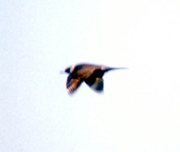
Photo © Nial Moores
Up to the end of May 2002 I have had at least 9 records of Pomarine Skua, involving ca 26 individuals. Sightings were in March, May, and again in September, October (one immature in Oct 2001 with CM), and November. Largest day count was 10+ on November 4th 1995, seen between Busan and Daema Do/Tsushima (with many more in Japanese waters).
Based on these sightings the Pomarine Skua appears to be the most numerous skua in Korean waters, as it is in Japan (Brazil, 1991), and as such its omission from the Korean list is surprising.
It may perhaps be explained by the fact that although individuals of several ages have been noted (including adults with full “spoons”), only this one individual has been satisfactorily photographed (though that from a moving boat, with a hand-held camera focused down the eye-piece of my binoculars!).
This pale phase individual shows (1) the typically heavy structure of Pomarine (somewhat intermediate between that of the scarcer Arctic Skua Stercorarius parasiticus and the rather rarer South Polar Skua Stercorarius maccormicki), along with (2) barred uppertail coverts; (3) an all dark cap, reaching down to the bill base, and (4) an obviously two-toned bill, with a blue grey base and a blackish distal third (all diagnostic of this species). The underwings appeared largely dark, suggesting, in combination with other features that it might probably be best aged as a subadult - perhaps 3rd calendar year.
Based on extensive experience of the species in the UK and in Japan, additional pointers favouring Pomarine are (5) its barrel-shaped body, (6) its bowed wings, (7) its heavy tail, angled downwards, (8) its strong pectoral band, with distinctive contrasting collar, suffused with buff or yellow, and (9) the extent of white in the primaries (with some white also showing on the primary coverts: a feature shown more strongly by South Polar). While records in Japan show a similar pattern of occurrence (with highest numbers in October and November, with a smaller peak in May) the present bias in records in Korea towards the spring and especially the autumn is likely also to be strongly influenced by the timing of Nial Moores's migrant-survey visits to outlying islands. As noted in Brazil (1991) Pomarine Skuas are often associated with Black-legged Kittiwakes Rissa tridactyla, a common winter visitor along the east coast, even occurring in small numbers as far west as Gageo Island. Mid-winter boat trips would help further to clarify the real status of this species.
Though only Arctic Skuas were recognised as having occurred in Korean waters when "Field Guide to the Birds of Korea" (Lee, Koo, Park 2000) was published, Pomarine Skuas do appear to be fairly regular offshore. Spring 2002 also saw the first documented record of Long-tailed Skua and Sooty Shearwater. It would seem that birders in Korea would be well-advised to keep their eyes peeled when making sea-crossings…



